Intel "Harpertown" Xeon vs. AMD "Barcelona" Opteron
by Jason Clark & Ross Whitehead on September 18, 2007 5:00 PM EST- Posted in
- IT Computing
AS3AP
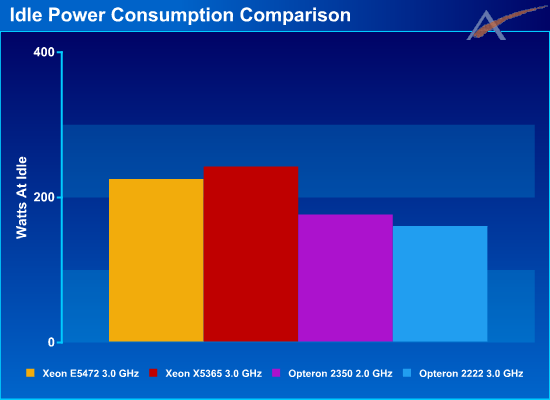
This graph shows that at idle the Intel systems use approximately 28% more power than the AMD systems. We can safely assume this is mostly due to Intel's use of FB-DIMMs -- and the results will be even worse as additional memory is added.
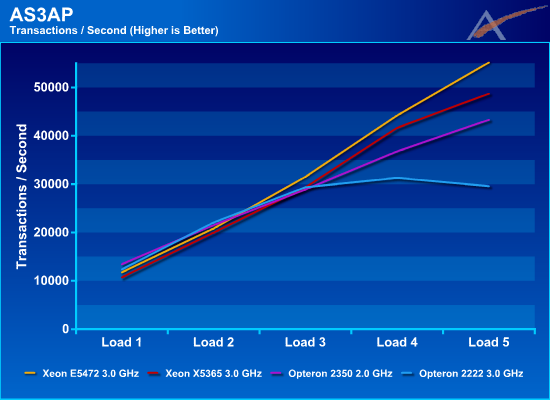
For the first two load points it is very close but AMD is able to lead by a small margin. Once we hit load point three the Xeon E5472 is able to take the lead with the X5365 close behind. You can clearly see the improvement of Harpertown over Clovertown here as Harpertown is as much as 13% faster than an equivalently clocked Clovertown. Harpertown is also able to outpace Barcelona by as much as 27%. You can also see that Barcelona is able to outperform dual-core Opteron by as much as 38%, despite the much slower clock speed.
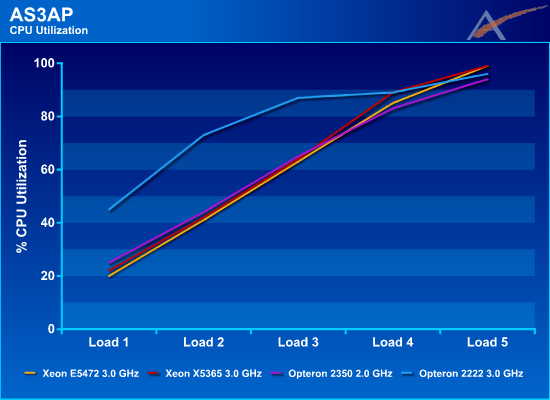
All quad-core processors exhibit similar CPU utilization for all load points. Again, we see the improvements of Harpertown as it consistently uses less CPU than Clovertown.
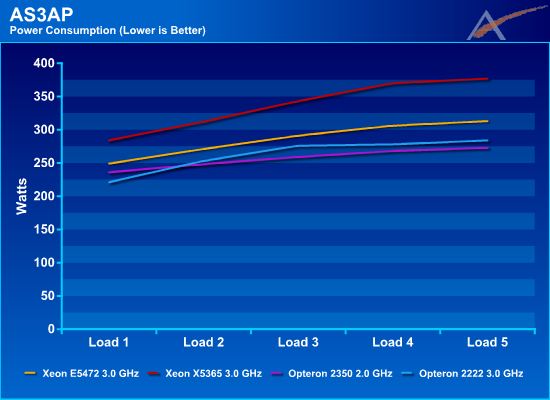
Keep in mind that the Xeon X5365 parts are 120W TDP and the Xeon E5472 parts are 80W TDP. Intel is getting much closer to competing with AMD on system power consumption but is still not there. Harpertown still uses as much as 14% more power than AMD.
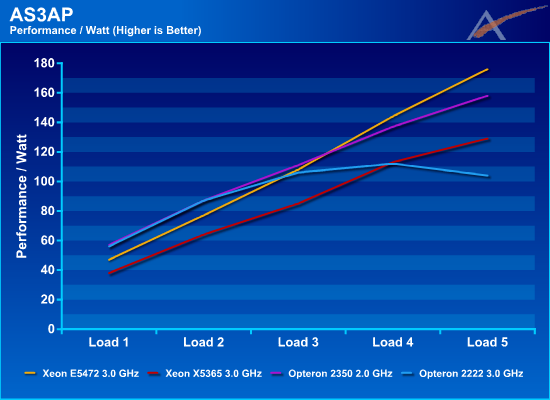
At the lower load points, where the platforms are very similar in performance, the AMD systems are able to take the lead by as much as 17%. From load point four and above the Xeon E5472 is able to pull ahead slightly, ending with a maximum lead of 11%.

This graph shows that at idle the Intel systems use approximately 28% more power than the AMD systems. We can safely assume this is mostly due to Intel's use of FB-DIMMs -- and the results will be even worse as additional memory is added.

For the first two load points it is very close but AMD is able to lead by a small margin. Once we hit load point three the Xeon E5472 is able to take the lead with the X5365 close behind. You can clearly see the improvement of Harpertown over Clovertown here as Harpertown is as much as 13% faster than an equivalently clocked Clovertown. Harpertown is also able to outpace Barcelona by as much as 27%. You can also see that Barcelona is able to outperform dual-core Opteron by as much as 38%, despite the much slower clock speed.

All quad-core processors exhibit similar CPU utilization for all load points. Again, we see the improvements of Harpertown as it consistently uses less CPU than Clovertown.

Keep in mind that the Xeon X5365 parts are 120W TDP and the Xeon E5472 parts are 80W TDP. Intel is getting much closer to competing with AMD on system power consumption but is still not there. Harpertown still uses as much as 14% more power than AMD.

At the lower load points, where the platforms are very similar in performance, the AMD systems are able to take the lead by as much as 17%. From load point four and above the Xeon E5472 is able to pull ahead slightly, ending with a maximum lead of 11%.










77 Comments
View All Comments
Xspringe - Wednesday, September 19, 2007 - link
Except in this particular case, based on the available data, this does not make sense at all. Power requirements of the AMD system are already lower then that of the Xeons (including the extra fans and ram), so these extra fans should not be required.Proteusza - Wednesday, September 19, 2007 - link
Hello? Anandtech? can we have some justification for the difference in test beds and the fact that performance per watt is now completely meaningless?Or are you just going to let this one slide?
Justin Case - Wednesday, September 19, 2007 - link
A difference of 50 watts would be enough to push the efficiency (performance per watt) of the Barcelona system above that of the Harpertown system in most of the benchmarks used in the article.DeepThought86 - Tuesday, September 18, 2007 - link
Wow if these numbers are representative then Barcelona is killing Intel, even at 45nm, on a $/performance basis and has great perf/watt too. A 2.5 GHz Barcelona will match anything Intel has until 2008 and a 3GHz Barcelona will obliterate them, period.Looks like Harpertown isn't enough to match AMD if they can get it scaled quickly. I think AMD will be making large server marketshare gains going forward until Nehalem is introduced. Great news for buyers!
defter - Wednesday, September 19, 2007 - link
Yeah right, because 3GHz Xeon has a 40-55% lead against 2GHz Barcelona, you will think that 2.5GHz (+20% clockspeed) Barcelona will overtake 3.2GHz Xeon?It's quite funny, two years ago when Intel was selling Netburst dual cores for $150-200 while AMD charged over $300 for a cheapest dual core CPU, nobody cared about performance/$ benchmarks :)
But now some fanbois are making up "performance/$", "performance/$/watt/clock", "performance/watt/Ruiz's IQ" metrics just to artificically boost AMD's poor CPU. This is enthusiast site, most people care also about which product is a simply faster, that's why omitting expensive or 120W CPUs from the reviews is a bit silly. Fastest CPU from manufacturer A vs. fastest CPU from manufacturer B is always a fair game.
Proteusza - Wednesday, September 19, 2007 - link
As the other guy said, its 25%, also, theres the fact that 1 AMD MHz is not equal to 1 Intel MHz.This may seem like utter fanboy crap, until you consider that a 1.8 GHz Intel Core 2 Duo generally outperforms a 3 GHz Intel Pentium 4.
Similar thing with how a K8 beat the pants off an equivalently clocked P4, and it looks like Barcelona is a very good performer.
You need to study computer architecture to understand why, but until then, keep your ignorance to yourself.
defter - Wednesday, September 19, 2007 - link
This is true, my mistake.
Here is your mistake, I was talking about percentage point increases, not MHz increases.
Ok, let's look back at example:
2GHz Barcelona performance: 1
3GHz Xeon performance: 1.4-1.55 (40-55% faster)
assuming perfect scaling:
2.5GHz Barcelona performance: 1.25 (in reality it will be less, since scaling is not perfect)
As you can see, even 2.5GHz Barcelona will not be as fast as current Xeons.
Why? Even the future 2.5GHz parts will be slow compared to competition.
You can look here for benchmarks between a future 2.5GHz Barcelona and 3GHz 45nm Xeon: http://www.techreport.com/articles.x/13224/1">http://www.techreport.com/articles.x/13224/1
Barcelona loses every real world test, in many tests it's significantly behind Xeon. Even when taking FB-DIMMs into account, Xeon has a lower power under load in Povray test.
And 3GHz Xeon isn't even a top speed part, in November Intel will introduce 3.16GHz quad core Xeon with faster parts coming later.
The fact is that AMD needs >3GHz Barcelonas in November, just to achieve parity with Xeon.
Spoelie - Wednesday, September 19, 2007 - link
server vs desktopon the desktop, barcelona will have a) a faster memory controller b) faster clocks c) faster memory (ddr667 on the server, ddr800 and ddr1066 on the desktop)
yes for desktop apps k10 needs more or less clock parity, but the original poster alluded to the target market for the opterons.
Proteusza - Wednesday, September 19, 2007 - link
K I see what you saying about relative performance.In most cases Barcelona seems to perform equal to an approximately equivalently clocked Harpertown.
So when a harpertown chip has a 50% clockspeed advantage, its going to beat any AMD chip until said AMD chip gets up to equal clockspeeds (approximately).
Nonetheless, I think its performance per watt figures should be pretty interesting, and I'm glad it generally outperforms a Clovertown at equivalent speeds. If it couldnt do that, it would be a dead duck.
flyck - Wednesday, September 19, 2007 - link
You are correct when you are talking about performance only related stuff. However barcelona won't be that far behind. Performance/wat will be better (is allready better if you consider that the more memory the worse the situation gets for intel).Why? Even the future 2.5GHz parts will be slow compared to competition
That sin't true. They will be very competive when we are talking about performance/W.
And i think that amd will be very performance competive vs intel when they can reach the 2.8GHz-3Ghz ratios which are due for start of the coming year. (especially when faster registerd ram is available).
Another comment that i would like to place is that on techreport you can hardly speak about server based benchmarks. although it does point out that amd will need frequency equality to be competive in the fanatic sector.